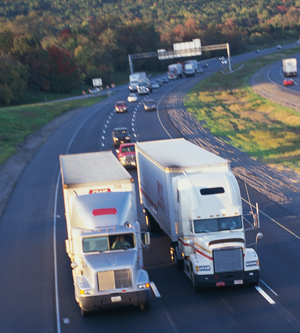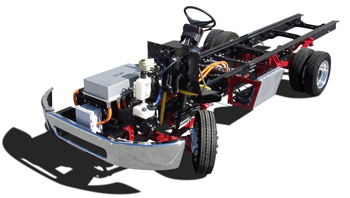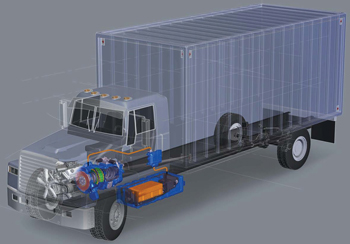6 Alternatives to Diesel for Freight Transport
By Kate Bachman | April 12, 2011
Category:
Freight vehicles, the behemoths of the road, haul as much as 80,000 pounds of product from coast to coast and pole to pole. Commercial vehicles consume as much as one-third of all motive fuel and are a significant emissions contributor, according to the Center for American Progress.
Unless they employ returnable packaging/racking systems, delivery of freight is the last leg of a manufacturer’s production cycle. Whether a manufacturer purchases and manages its own freight fleet or outsources it to a freight transport company, transporting sustainably produced goods by less than ecofriendly means can be a last-round black eye on an otherwise green production process and can
muck up the works for even the greenest of manufacturers.
Increasingly, fuel cost increases, government regulations (see Government Regulations sidebar), and concern for the environment are driving manufacturers to explore alternative fuel and power sources for the freight fleets that deliver their products (see Trucking Industry Heavyweights Develop SuperTrucks
sidebar).
Several new and newer alt-powered vehicles and fuel types were showcased at the Mid-America Trucking Show in April in Louisville, Ky.
Six major types of alternative-powered systems and alternative fuels include electric drive trains, hybrid-electric drive trains, hydraulic hybrid power systems, natural gas-, biodiesel-, and propane-fueled.
So how do the drive trains or fuel systems work? How are they different from traditional propulsion systems? What are their best applications?
1. Electric
Electric drive systems are powered by an electric motor or generator, with power stored onboard in battery packs. They consume no fossil fuels for propulsion or operation.
Freightliner Custom Chassis Corp. (FCCC) a Daimler Trucks NA company, Gaffney, S.C., has begun full production of an all-electric, light-freight delivery truck chassis—the first in the industry. The chassis is currently undergoing testing with major U.S. pickup and delivery fleets (see Figure 1).
“In partnership with Enova, we have developed an all-electric chassis to meet the environmental, economic, and performance needs of our commercial vehicle customers,” said FCCC President Bob Harbin. This is the only walk-in van chassis in the industry to be completely electrically powered, Harbin said.

Figure 1
An all-electric chassis, co-developed with Enova Systems and using Tesla lithium-ion batteries, powers FCCC’s E-Cell walk-in van. The E-Cell is the only domestically engineered all-electric chassis, and the industry’s first in North America. Image courtesy of Enova Systems, Torrance, Calif.
Enova, Torrance, Calif., contributes “enabling technologies” in alternative-energy propulsion systems for light- and heavy-duty vehicles. The project involved the engineering and integration of Enova’s 120-kilowatt (kW) all-electric drive system technology into FCCC’s new MT-45 chassis.
The electric chassis’ power storage—including its HVAC system—uses Tesla Motors lithium-ion batteries. FCCC is the first company within the industry to use Tesla batteries for commercial applications, said Mike Staran, president and CEO of Enova Systems. The drive system’s 120 kW battery packs have a maximum100-mile driving range on a single charge. The battery pack charges from fully depleted
to fully charged in six to eight hours.
The batteries also capture and store energy during the regenerative braking phase of the vehicle’s operation. The regenerative braking system saves energy by recycling and storing it, instead of losing it to heat, which can then be reused to propel the vehicle.
Because the range of an electric vehicle is limited by weight, design, and the type of battery used, EVs are particularly well-suited to short-distance, high-use applications—those that demand frequent starts and stops, such as light-duty delivery vehicles.
2. Hybrid Electric
Eaton Corporation, Cleveland, develops and manufactures hybrid electric power systems for freight vehicles, which boost fuel economy and reduce particulate emissions in trucks as well as buses and service vehicles, according to Eaton’s James Parks, manager of global communications fleets (see Figure 2).
“By definition, a hybrid vehicle uses two or more distinct power sources to move,” Parks said. “Our hybrid system combines a truck’s traditional internal combustion engine with an electric motor and batteries to move the vehicle forward. Then, through regenerative braking, the system recharges itself.”
On average, hybrid electric power systems can reduce fuel consumption by 35 percent—in some applications, the reduction can be even higher. The applications that realize the best fuel efficiencies using this hybrid power system are commercial vehicles that stop and start frequently or that idle at work sites to run accessories or tools, Parks added.

Figure 2
Hybrid electric power systems combine a truck’s traditional internal combustion engine with an electric motor and batteries to move the vehicle forward. They can reduce fuel consumption by 35 percent. Image courtesy of Eaton Corp., Cleveland.
Eaton’s patented hybrid electric power system uses a parallel configuration that maintains the vehicle’s conventional drive train layout and uses patented controls to blend engine torque with electric torque to move the vehicle.
The system recovers power normally lost during braking and stores the energy in batteries. It can provide engine-off power, take off and work-site capability for those needing hydraulic operations and an auxiliary electric power source from the vehicle.
“To build the system, we couple the vehicle’s engine with our own UltraShift® automated manual transmission and clutch,” Parks said. “Between the output side of the clutch and the transmission, we integrate an electric motor/generator that is connected to a power inverter and lithium-ion batteries and controlled with our own electronic control module.”
Diesel/Electric. Florence, Ky.,-based ePower Engine Systems LLC, a developer of hybrid drive train technology, debuted the company’s proprietary diesel/electric engine system for the over-the-road transportation industry at the Mid-America Trucking Show.
The hybrid technology reduces fuel consumption—and hence CO2 production—by as much as 65 percent under normal conditions of use and without reducing performance, according to the company.
The system can be retrofitted and uses off-the-shelf components.
No advanced battery technology is employed in the epower engine system. Instead, standard lead acid batteries are used.
3. Hydraulic Hybrid
Eaton also produces hydraulic hybridpower trains. The company’s patented Hydraulic Launch Assist™ or HLA® hydraulic hybrid system has two main parts—regeneration and acceleration, Eaton’s Parks said.
For acceleration, the fluid in the high-pressure accumulator is released to drive the pump/motor as a motor. The motor then propels the vehicle by transmitting torque to the driveshaft.
During regeneration, the vehicle’s kinetic energy that is normally lost during braking is captured and used to drive the pump/motor as a pump. The pump action transfers hydraulic fluid from a low-pressure reservoir to a high-pressure accumulator, he explained. As the fluid pumps into the accumulator it compresses nitrogen gas and pressurizes the system. The regenerative braking captures about 70 percent of the kinetic energy produced during braking.
“Accumulatively, customers using our hybrid systems globally have reduced their fuel consumption by 6 million gallons and harmful emissions by 60,000 metric tons over more than 150 million miles,” Parks said.
4. Natural Gas
Natural gas is emerging as a domestically available and economical alternative to diesel fuel.
Natural gas, comprised mostly of methane, is one of the cleanest burning fossil fuels, according to the Center for American Progress. It says natural gas produces less than half as much carbon pollution as coal for electricity and up to 25 percent less than oil for transportation.
But methane has some drawbacks. One is its low energy content. It takes about 100 cubic feet of methane to deliver the same amount of horsepower as a gallon of gasoline. Consequently, natural gas must be compressed (CNG) or liquefied (LNG), and it requires heavy, high-pressure fuel tanks.
LNG and CNG are replacements for petro-diesel and are suitable to fuel heavy-freight vehicles, as well as cars, the center states.
Compressed. To provide adequate driving range, CNG must be stored onboard a vehicle in tanks at high pressure—up to 3,600 pounds per square inch, according to the U.S. Dept. of Energy (DOE). A CNG-powered vehicle gets about the same fuel economy as a conventional gasoline vehicle on a gasoline gallon equivalent (GGE) basis, according to the DOE. (A GGE is the amount of alternative fuel that contains the same amount of energy as a gallon of gasoline. A GGE equals about 5.7 lbs. of CNG.)
Liquefied. One way to extend the driving range of a natural gas-powered vehicle is to liquefy the natural gas (LNG). Chilling methane to -260 degrees F reduces its volume by a factor of 630-to-1, allowing more fuel to be stored in a smaller tank. During this process, when the natural gas is cooled below its boiling point, certain concentrations of hydrocarbons, water, carbon dioxide, oxygen, and some sulfur compounds are either reduced or removed.
LNG is also less than half the weight of water, so it will float if spilled on water. At atmospheric pressure, LNG occupies only 1/600 the volume of natural gas in vapor form. A GGE equals about 1.5 gallons of LNG, the DOE says.
Because it must be kept at such cold temperatures, LNG is stored in double-wall, vacuum-insulated pressure vessels. LNG fuel systems typically are used only in heavy-duty vehicles.
But a supercold cryogenic fuel tank cannot keep the methane liquid cold indefinitely. As the fuel warms up, it begins to vaporize and must either be vented or used.
LNG costs more than CNG because of the costs of the chilling equipment.
As a motor fuel, LNG has the highest octane rating—130—of any of the other alternatives, which means it can handle compression ratios of up to 15-to-1.
Landfill Gas. Waste Management, based in Houston, is evaluating and developing a range of technologies that could create fuel, such as LNG, for fleet and other vehicles from landfill gas.
The company is not only a leading provider of waste services that include collection, transfer, recycling, and resource recovery and disposal, it is also the largest residential recycler and a leading developer, operator, and owner of waste-to-energy and landfill gas-to-energy facilities in North America, according to Wes Muir, director of corporate communications for Waste Management.
Waste Management has the world’s largest fleet of heavy-duty natural gas refuse and recycling trucks—853: 351 compressed natural gas and 491 liquefied natural gas, Muir added.
“Our company is committed to extracting the maximum value from the materials it manages by converting materials’ waste into beneficial reuse products such as renewable energy, transportation fuels, and chemicals,” Muir said.
5. Biodiesel
Common compression-ignition internal combustion engines are traditionally fueled by diesel derived from petroleum oil. Biodiesel can completely or partially replace diesel fuel. It is an organically based product and is renewable.
Biodiesel is relatively easily produced from plant and animal oils, fats, and greases and often is a byproduct of food processing. (see “Biodiesel—ready to rumble; Engine-ready, less toxic than table salt, more biodegradable than sugar.”)
Compared to diesel fuel, biodiesel is cleaner-burning, made from natural, renewable sources such as vegetable oils; and produces lower carbon emissions than diesel, according to the National Biodiesel Board.
“Biodiesel can be operated in any compression-ignition (diesel) engine with little or no modification to the engine or the fuel system,” the bBoard said in the article.
“Biodiesel is the first and only alternative fuel to have a complete evaluation of emission results and potential health effects submitted to the U.S. Environmental Protection Agency (EPA under the Clean Air Act Section 211(b),” according to the board.
The results show that pure biodiesel (B100) has 67 percent fewer total unburned hydrocarbons; 48 less carbon monoxide; and 47 percent less particulate matter than diesel fuel.
6. Propane
Propane, also known as liquefied petroleum gas (LPG), is another alternative to petrol. Like natural gas, propane is a gaseous fuel, so it is a vapor at room temperature and must be contained in a special high-pressure fuel cylinder. About 60 percent of the propane that is produced comes from natural gas wells; the rest is a byproduct of crude oil refining.
“Propane offers an environmentally friendly alternative to diesel and gasoline, increases energy security, and provides significant economic savings,” said Brian Feehan, vice president of the Propane Education & Research Council at an Alternative Fuels & Vehicles National Conference & Expo in May 2010.
Cummins,www.cummins.com
Daimler Trucks North America, www.daimlertrucksnorthamerica.com
Eaton,www.eaton.com
Enova Systems, www.enovasystems.com
Freightliner Custom Chassis Corp., www.freightlinerchassis.com
National Biodiesel Board (NBB), www.biodiesel.org
Navistar Inc., www.navistar.com
Peterbilt, www.peterbilt.com
Propane Education & Research Council, www.propanecouncil.org
U.S. Department of Energy, www.energy.gov
Waste Management Co., www.wm.com
Trucking Industry Heavyweights Develop SuperTrucks
In January 2010, the U.S. Department of Energy (DOE) awarded $115 million in funding to three major manufacturers to develop highly efficient fleet vehicles to improve fuel efficiency by 50 percent by 2015.
The DOE chose Cummins, Daimler Trucks North America, and Navistar to develop “Super Trucks.” Every aspect of energy consumption by a Class 8 tractor-trailer will be addressed through the development and integration of advanced technologies. The manufacturers are to apply the $115 million to develop and demonstrate systems-level fuel efficiency technologies, including improved aerodynamics,
engine idling reduction, waste heat recovery, advanced combustion techniques, and power train hybridization.
The funding is part of a larger effort announced by U.S. Secretary of Energy Dr. Steven Chu to invest $187 million in nine projects to improve fuel efficiency in heavy-duty trucks and passenger vehicles.
“Improving the efficiency of our vehicles is critical to reducing America’s dependence on foreign oil and addressing climate change,” said Chu. “Today’s awards will help demonstrate the potential benefits for long-haul trucks and passenger vehicles and will play an important role in building a more sustainable transportation system for the country.”
Cummins, Columbus, Ind., was awarded nearly $39 million to develop and demonstrate a highly efficient and clean diesel engine, an advanced waste heat recovery system, an aerodynamic Peterbilt tractor-trailer combination, and a fuel cell auxiliary power unit to reduce engine idling, the DOE’s announcement stated.
Cummins chose Peterbilt Motors Co., a division of PACCAR, to partner on the project to develop an aerodynamic tractor and trailer combination.
Cummins also selected Eaton to participate in the program to develop a next-generation automated transmission, Eaton spokesperson James Parks, manager of global communications, said.
Other technologies Cummins uses to reduce emissions include a NOx adsorber catalyst, selective catalytic reduction, cooled exhaust gas recirculation, diesel particulate filters, and diesel oxidation catalysts.
Daimler Trucks North America, Portland, Ore., received about $40 million to develop and demonstrate technologies including engine downsizing, electrification of auxiliary systems such as oil and water pumps, waste heat recovery, improved aerodynamics, and hybridization. The funding is shared by DTNA’s sister company, Detroit Diesel.
Navistar Inc., Fort Wayne, Ind., has tapped more than $37 million to develop and demonstrate technologies to improve truck and trailer aerodynamics, combustion efficiency, waste heat recovery, hybridization, idle reduction, and reduced rolling resistance tires.
The participating manufacturers’ leadership welcomed the SuperTrucks funding and the accompanying challenge. “This funding enables us to significantly accelerate our research and development of advanced technologies,” said Elmar Boeckenhoff, senior vice president, engineering and technology, for DTNA and director of the DTNA SuperTruck project team.
“Companies that master sustainability and leverage it as a competitive advantage will emerge as the leaders in the coming decade,” Eaton Chairman, Alexander “Sandy” Cutler said of the project.” Our company’s ability to develop innovative products and processes that help customers and consumers conserve resources and reduce their carbon footprint is crucial in making Eaton one of those leaders. Eaton’s success in this area is a key factor in achieving competitive advantage and making the world a better place,” Cutler added.
The projects are expected to create more than 6,000 research, engineering, manufacturing and assembly jobs.

Side by side, we move metal fabrication forward.
FMA unites thousands of metal fabrication and manufacturing professionals around a common purpose: to shape the future of our industry, and in turn shape the world.
Learn More About FMA


